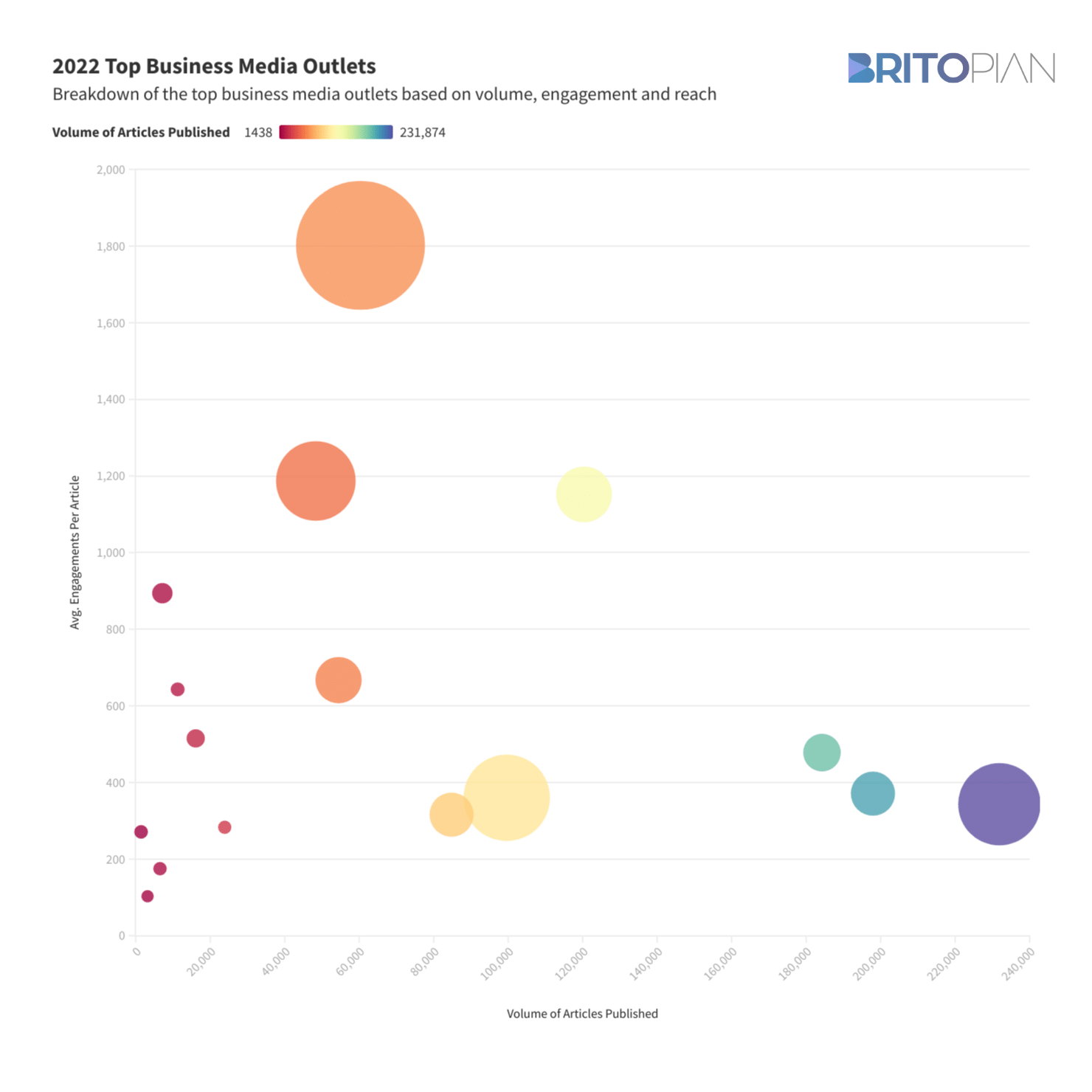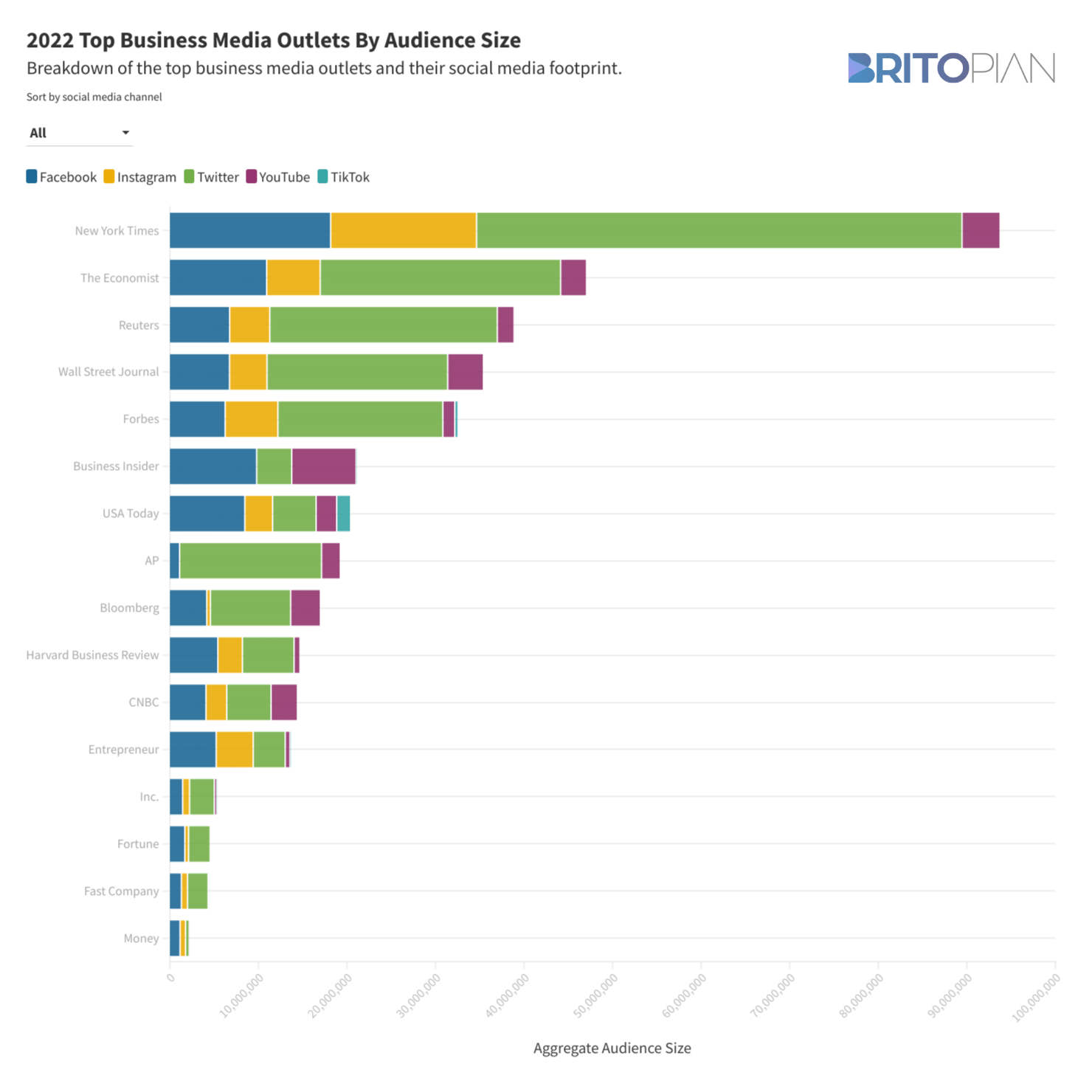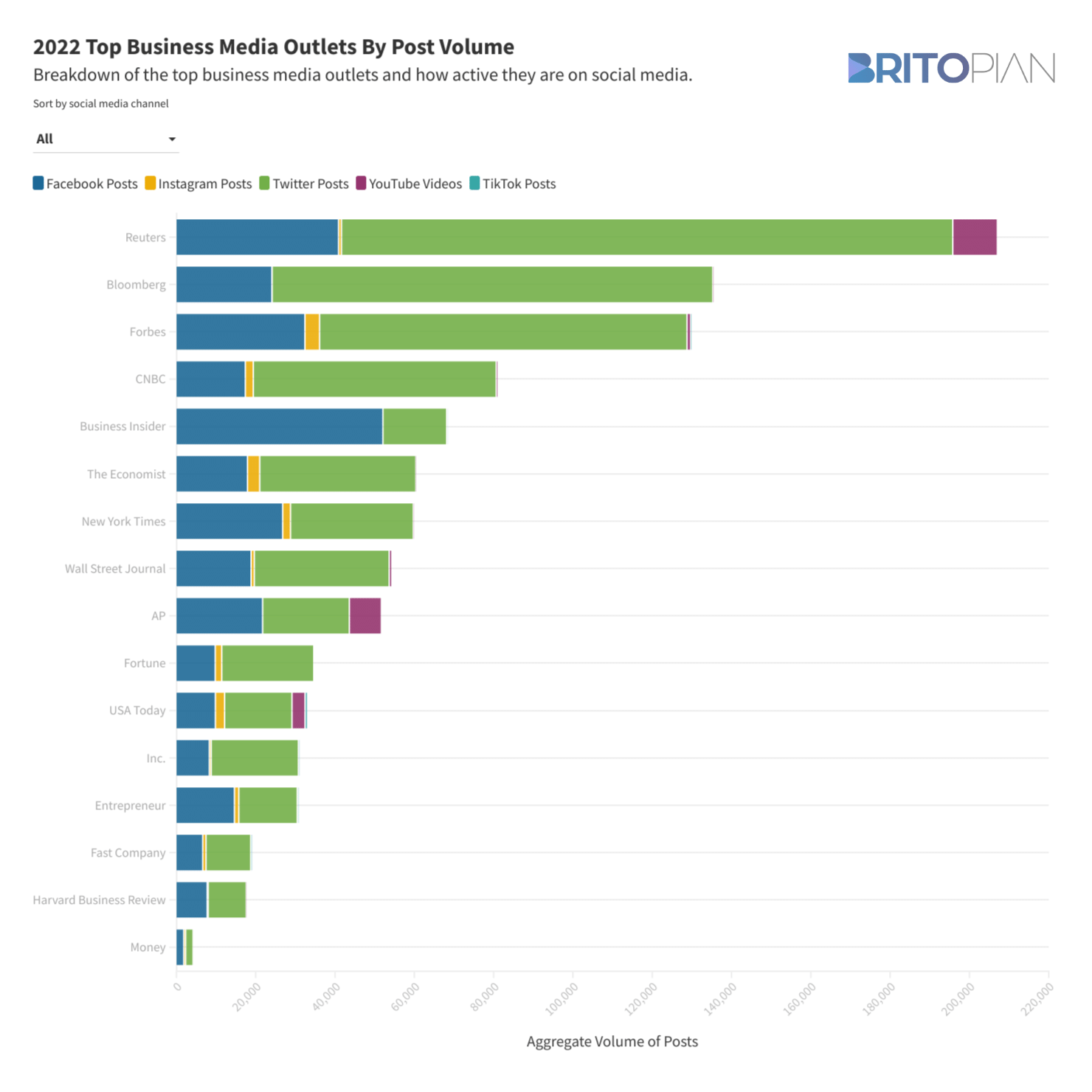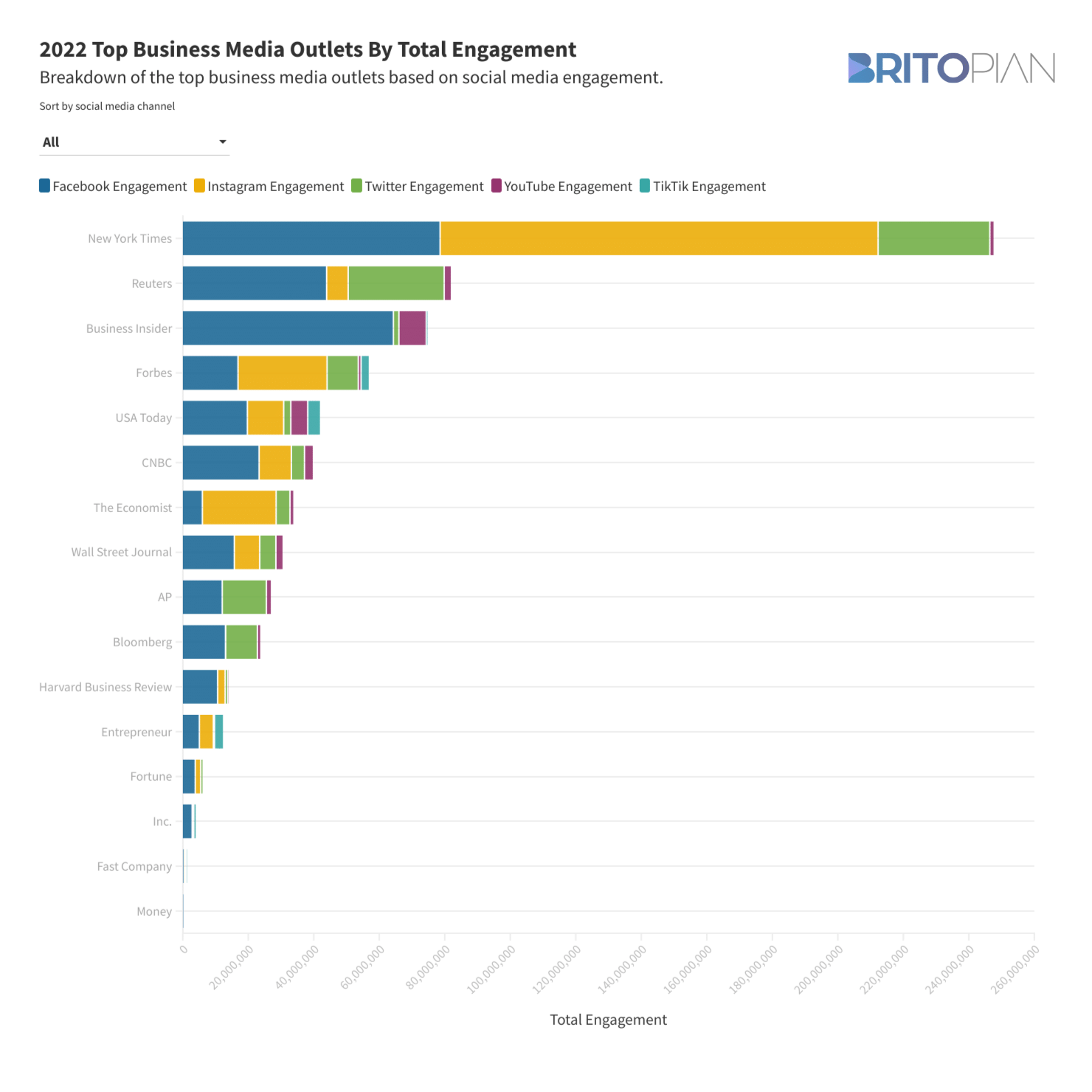Key Takeaways 📈 📊
- Data Drives PR Precision: PR professionals are shifting from guesswork to data-driven strategies. By analyzing media placements, they can identify which outlets and journalists will likely cover their stories, leading to more targeted and effective pitching.
- Engagement Over Volume: High article volume doesn’t guarantee engagement. Outlets like the New York Times not only publish a large number of articles but also see high engagement, indicating a deeply invested readership.
- Major Outlets, Major Impact: Publications like Forbes and The Wall Street Journal are key for mass market reach and credibility. Coverage in these outlets can significantly enhance a company’s reputation and visibility through third-party validation.
- Social Media as a Distribution Powerhouse: Social media platforms are crucial for distributing stories and engaging audiences. The presence and activity of business media on platforms like TikTok and Instagram can amplify reach, especially among younger demographics.
- The Rise of Niche Publications: Smaller outlets like Harvard Business Review and Inc. may offer lower volume but can provide highly engaged niche audiences for targeted PR campaigns.
- Analytics Inform Strategy: A significant percentage of PR professionals recognize the complexity of PR measurement today, with many using marketing and technology software to inform their strategies.
- Audience Growth Indicates Trend Shifts: Only a few outlets, like Reuters and CNBC, have seen double-digit audience growth on social media, suggesting a plateau in audience expansion for others, which may signal a shift in content strategy or platform usage trends.
PR Pros: Stop Being Afraid of Data
PR professionals can no longer rely on guesswork and hope when securing media coverage. They must move from merely hoping their press releases and pitches will garner pickup to knowing which outlets and reporters will most likely provide coverage.
Measuring PR and media coverage has become more challenging in recent years due to the proliferation of digital platforms, data sources, and measurement methods.
The key to this transition is data. By tracking and analyzing past media placements, PR pros can zero in on the top business publications and journalists covering their industry. For example, a review of past tech client coverage may show that WIRED, TechCrunch, and VentureBeat have provided the most articles on product launches. The data may also reveal go-to tech reporters at mainstream outlets like The Wall Street Journal and the New York Times.
With these insights, PR teams can apply more rigor, tailor their pitches, and build relationships with these high-value targets. They can pitch exclusive stories to top tech reporters at mainstream outlets to increase the chances of mass market exposure. Or they may pitch product announcement stories to niche tech blogs, knowing they have an appetite for that coverage. The data provides clarity on where and whom to pitch.
The days of spray and pray pitching are over. By taking a data-driven approach, PR professionals can move from hoping for media placements to knowing which outlets and reporters will be receptive. The result is greater media coverage and exposure for their clients.
What’s the Data Say?
Tell the truth. Do you pitch the media based on intuition? Maybe you Google “top business media outlets” and use someone else’s list. Perhaps that’s a starting point, but I wouldn’t do it this way.
Why this matters: It matters because hope and intuition is not effective PR strategy. It’s important, but there are more important indicators that you can use to devise a more strategic media relations strategy. Start with data and then layer in your experience and intuition.
The data is clear. PR pros still have a significant opportunity to use data and analytics to inform how they plan for their media relations program. Below are a few examples of using analytics to your advantage.
As mentioned, data is only as good as the person interpreting it or contextualizing the findings. Therefore, for any successful PR plan, it is essential to have the right combination of data, intuition, and personal experience. Going through this exercise will help you build your media list.
- 60% of PR pros say it’s more complicated to measure PR today than in previous years
- 61% of PR pros use marketing and technology software monthly
- 21% of PR agencies list measurement and analytics as having the most significant impact on the industry
- 21% of PR pros are comfortable using data and analytics in their daily jobs
Understanding Business Media
The top business media outlets—including major publications like Forbes, Fortune, Bloomberg Businessweek, and The Wall Street Journal—are critical targets for PR professionals. They provide the mass market reach and industry credibility needed to boost a company’s reputation and visibility. Securing coverage in these renowned business outlets offers third-party validation of a brand’s offerings, executive thought leadership or company news.
These publications have built loyal audiences of business leaders and industry insiders who turn to them for insights on the latest trends. Placement in these business outlets can drive awareness, interest, and engagement across a company’s key audiences. The resonant stories range from profiles of up-and-coming brands, Q&As with CEOs, and features on new product launches to thoughtful columns on innovation and leadership. For B2B companies especially, coverage in these tier-one business outlets lends immense credibility.
Example Report: Business Media By Impact
The business media outlets in this report were pre-defined. They were curated based on industry knowledge and my experience analyzing news articles over the past 15 years. Also, there is no topical analysis layered into this data. These are raw numbers and account for all articles published in 2022 on each business news outlet.
The data is visualized using three metrics–the volume of media coverage, the average engagement per article, and the total reach of each business outlet. The volume of media coverage is the total number of articles published in 2022. The average engagement per article is the total number of engagements divided by the total volume of articles. Finally, the reach is calculated using monthly web traffic numbers.
Hover over the circles to see the business outlets and the corresponding metrics.
In this data set, USA Today, Associated Press, and Reuters are the top three media publications based purely on the volume of articles published in 2022, with USA Today leading at 231K articles. However, the average engagement per article is low, ranging from 250 to 500 engagements per article posted.
Business media outlets like the New York Times, CNBC, the Wall Street Journal, and Business Insider not only drive the volume of coverage, but their engagements are high, with the New York Times leading with 1.8K engagements per article posted.
Smaller media outlets like Harvard Business Review, the Economist, Entrepreneur, and Inc. are low-volume outlets with varying degrees of engagement per article.
This type of information helps understand how the readership of each media outlet is engaged with media coverage. But, of course, these numbers would paint a completely different story if we were to layer in different topics.
Also, what is not reflected in this data is whether any of these media outlets are using paid media to drive engagement with their coverage. The more paid media invested would naturally drive up the engagement numbers.
Download: Top Business Media by Impact below
Example Report: Business Media by Audience Size
This data is a 2022 snapshot of each business media outlet ranked by audience size on social media, tracking channels like Facebook, Instagram, Twitter, YouTube, and TikTok.
Why is this data important? Most business news and media outlets use social media to distribute stories across various networks. It drives reach and engagement and indicates how each outlet tries to reach new audiences.
In the drop-down menu, if you select TikTok, you’ll see a sorted list of the media outlets using TikTok to distribute news and engage audiences. Unfortunately, only USA Today, Forbes, Entrepreneur, Business Insider, Inc., Fast Company, and Bloomberg have a presence on TikTok. It’s baffling to me, considering that Gen Z media consumption over indexes on TikTok.
Download: Top Business Media by Audience Size below
Example Report: Business Media By Coverage Volume
This data is a 2022 snapshot showing how active each media outlet is when posting on their social media channels. This number should not be confused with coverage volume. Coverage volume is the total number of articles posted on the outlets. Coverage volume is what’s published on social media. It’s very rarely the same number.
Why is this data important? Typically, if a specific business news outlet has a large footprint on social media, it usually equates to them posting frequently. A glance shows that most of these outlets are active on Twitter and Facebook. Like the above graph, if you select TikTok Posts in the drop-down menu, you’ll see the same outlets and their corresponding post volume for 2022.
Sorting by YouTube videos shows more activity for most media outlets except Money and Fortune.
Download: Top Business Media by Post Volume below
Example Report: Business Media By Article Engagement
This data is a 2022 snapshot showing the total engagement on each social media channel. For example, if you hover over the New York Times, you’ll see 78M engagements on Facebook, 133M on Instagram, 34M on Twitter, and 1.1M on YouTube.
Why is this data important? While this could be considered a vanity metric, it is a good indicator of how engaged the media outlet’s audience is on each social media channel.
If you sort by Instagram engagement, you’ll see that most media outlets drive engagement with their audiences except for Fast Company, Money, Inc., Bloomberg, Business Insider, and The Associated Press. Sorting by TikTok Engagement tells a similar story but with different players. Only USA Today, Entrepreneur, Forbes, Inc, Business Insider, and Fast Company have decent engagement numbers on the platform.
Download: Top Business Media by Engagement below
Business Media Trend Data (YoY)
When comparing 2021 to 2022 data, only two media outlets experienced double-digit audience growth on social media, Reuters (13.2%) and CNBC (15.2%). This tells me that most other outlets have leveled off regarding social media audience growth.
Social media publishing has decreased for media outlets like Fast Company (-42.2%), Business Insider (-13.3%), and The Economist (-6.6%). There could be several reasons why this is happening. Perhaps there’s a shift in strategy, budget cuts, or engagement is down, resulting in a lackluster performance.
Social media publishing has increased for other media outlets like The Associated Press (+65.3%), Entrepreneur (+29%), Bloomberg (+15.9%), and Fortune (+19.2%). Most of this activity is primarily on Facebook and Twitter.
Media outlets saw decreased engagement numbers across their social media channels except for Business Insider (+14.6%), Entrepreneur (+56%), Fortune (+510%), and Money (+29%). For context, Fast Company’s social engagement rate dropped 35%, followed by Forbes at 29.4% and USA Today at 237%. Some of these media outlets will publish the same article multiple times a day, which could be the reason for the drop in engagement.
The average size of social media audiences is 23.4M (Facebook, Instagram, Twitter, YouTube, TikTok).
Wrap-Up Thoughts
The dynamic landscape of business media today requires PR professionals to take a more targeted, data-driven approach to securing meaningful coverage. The old ‘spray and pray’ pitching model is obsolete. Instead, by leveraging data analytics to identify key media outlets and journalists, PR teams can focus on those most likely to provide valuable coverage for their client or industry. This strategic approach ensures PR activities are not wasted but concentrated on publications and reporters with an established interest in the subject matter.
Beyond getting coverage, it’s about understanding nuances like coverage volume versus engagement. An integrated analysis using both data and human intuition is crucial for tailoring strategies that cut through the complexities of today’s fragmented business media. For PR success today, professionals must move from hoping for media pickup to knowing exactly where coverage will resonate.
Download Business Media Graphs
Top Business Media by Impact

Top Business Media by Audience Size

Top Business Media by Post Volume

Top Business Media by Engagement

